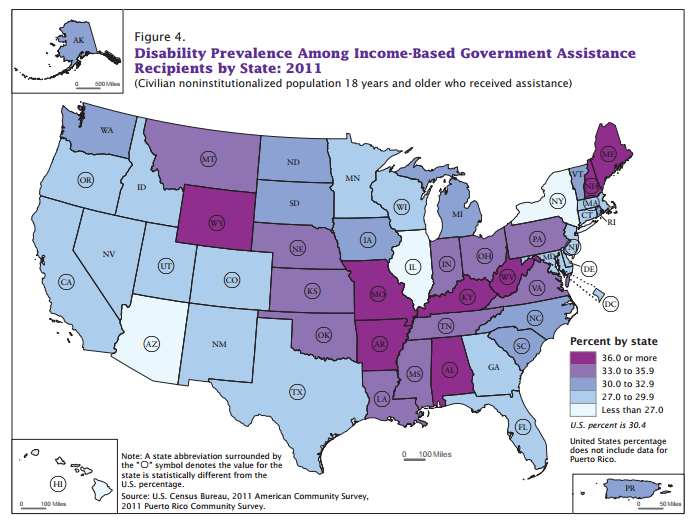One-Third of Adults Receiving Need-Based Government Assistance Have a Disability
As Dustin and I documented in the second part of our series on poverty and the social safety net in Virginia, need-based government social safety net programs are typically targeted towards specific subgroups of low-income individuals: single mothers and their children, working adults, and individuals with disabilities. While poor single female-headed households and the working poor have received significant attention among researchers, the disabled population has received less attention, in part because regularly available, high quality data that capture aspects of disability status have only recently become available.
This past Tuesday, the Census Bureau released a report, Disability Characteristics of Income-Based Government Assistance Recipients in the United States: 2011, which uses 2011 American Community Survey data to document the disability prevalence and type among U.S. adults 18 and older receiving need-based public assistance. Nationally, 30.4% of adults receiving need-based government assistance report some type of disability. Virginia, like many of the states along the Appalachian mountains, has a slightly higher rate of disability among adults receiving need-based aid: 33.4%.

This high disability prevalence among individuals receiving need-based aid reflects both high unemployment rates among the disabled population and, among the population that is working, lower average wages. These broad patterns are replicated in Virginia.
In 2011, among working-age Virginians (ages 16 to 64):
- 60% with a disability were out of the labor force, meaning they are neither working nor looking for work. This is triple the out-of-the-labor-force proportion of non-disabled working-age Virginians (20%).
- Among individuals in the labor force, Virginians with disabilities reported higher unemployment rates, greater part-time work, and lower employment in professional occupations.
Consequently, compared to non-disabled Virginians, individuals with any disability report lower median incomes and are more likely to fall below the poverty line, receive food stamps, and rely on public health insurance, such as Medicaid, for medical care. While participation in these need-based government transfer programs is significant for alleviating poverty, the poverty rate among disabled Virginians remains high: 20%, even after accounting for taxes and transfers.
For more information, please visit our report on Working-Age Virginians with Disabilities.


